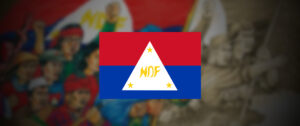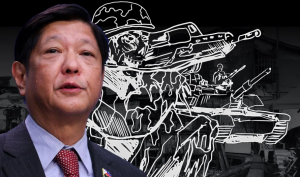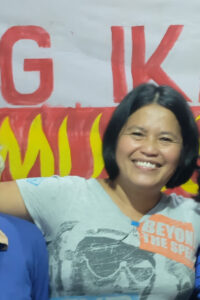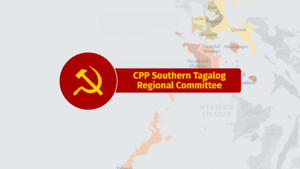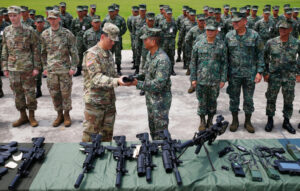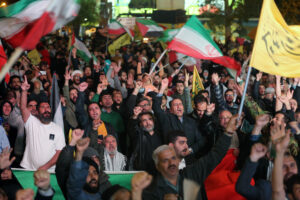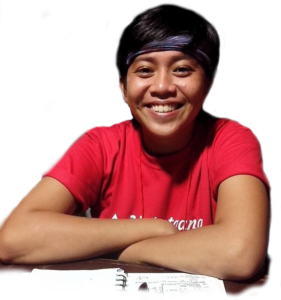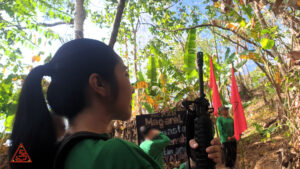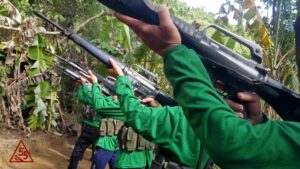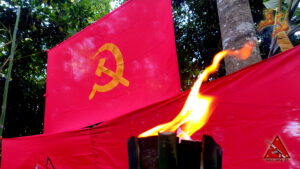Frustrate the vicious counterrevolutionary war of the US-Duterte fascist regime! Strive to carry forward the people’s war!
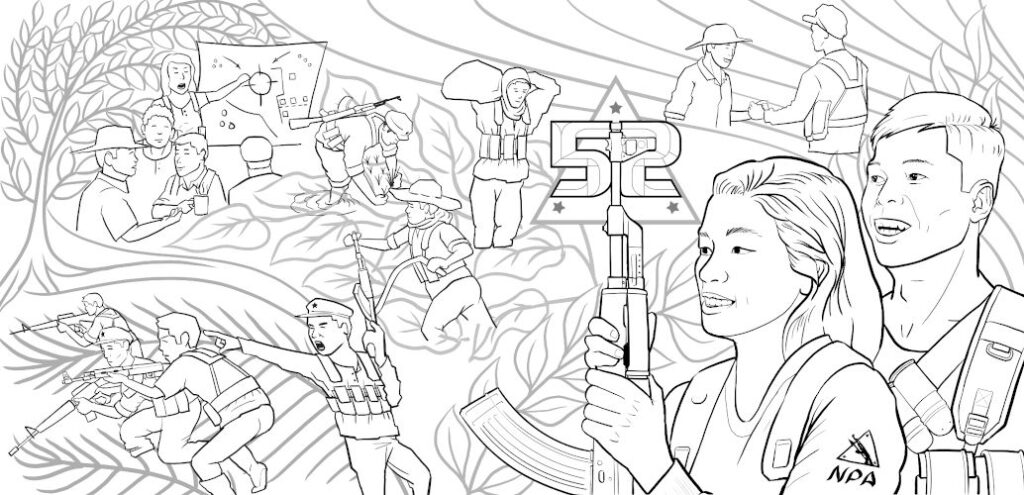
I. Global capitalist system remains in recession
II. State terrorism intensifies as Duterte schemes to perpetuate fascist reign beyond 2022
III. The NPA perseveres amid all-out counterrevolutionary suppression
IV. Strive to carry out the fighting tasks of the NPA
Download here: PDF | EPUB | MOBI
Read in: Pilipino | Bisaya | Spanish | Hiligaynon | Catalan
The Central Committee firmly salutes all Red fighters and commanders of the New People’s Army (NPA) on the occasion of its 52nd anniversary. On this day, we give our profound recognition to the resolute and vigorous efforts, achievements and sacrifices being made by the NPA in defending the people and waging people’s war in the face of the vicious and dirty counterrevolutionary war of the US-Duterte fascist regime.
We pay the highest tribute to all the Red fighters and Party cadres who gave their lives while serving the people and their revolutionary cause. Their names are forever etched as heroes and martyrs in the annals of the Filipino people’s epic struggle for national and social liberation.
On this day, it is fitting that together with the entire NPA, the Party pays special tribute to Antonio Cabanatan (Ka Manlimbasog), former member of the Central Committee, the Political Bureau and Executive Committee who, together with his wife, Florenda Yap (Ka Osang), was abducted last year, secretly detained and tortured for months before being brutally killed by Duterte’s cowardly murderers.
Ka Manlimbasog, who retired in 2017 from active revolutionary duties, was among the courageous pathfinders who led in the expansion of the people’s army in the Visayas and Mindanao. He made immense contributions to the growth and strengthening of the revolutionary movement.
The Party also salutes Rosalino Canlubas (Ka Yuni) NPA regional commander of Cagayan Valley and deputy secretary of the regional Party committee who died in an encounter last March 15 in Isabela. Ka Yuni was among the young cadres elected to the Second Central Committee for his brilliant contributions in waging armed struggle in Southern and Western Mindanao.
Let us make use of this occasion to take stock of our strength by pointing out both our achievements and shortcomings over the past year. Let us aim to further develop our strengths and overcome our weaknesses in order to more effectively wage people’s war by extensively and intensively carrying out guerrilla warfare on an ever widening and deepening mass base. We must also study the enemy’s strength and weaknesses in order to devise the plan, strategy and tactics to frustrate his relentless and brutal war against the people.
The people’s war being waged by the NPA, under the absolute leadership of the CPP, is part of the 500-year continuum of armed resistance by the Filipino people against foreign aggressors and oppressors, with the first victory at the Battle of Mactan in April 27, 1521 where Datu Lapu-Lapu defeated the horde of Spanish conquistadores led by Ferdinand Magellan. For five centuries, under 300 years of Spanish colonial rule and more than a century of US colonial and semicolonial oppression, the Filipino people have arduously waged revolutionary armed resistance to attain genuine national freedom.
The ever worsening socioeconomic conditions of the Filipino people remain ever favorable for waging extensive and intensive guerrilla warfare. By its corruption, anti-people policies and fascist suppression, the US-Duterte regime has aggravated the crisis of the ruling semicolonial and semifeudal system and has imposed more hardships and oppression on the broad masses of the Filipino people.
The past year has brought untold suffering on the broad masses of workers, peasants, semiproletariat and the petty bourgeoisie as a result of the bungled response to the Covid-19 pandemic. By relying primarily on police and military restrictions, instead of the necessary public health measures, the reactionary regime has collapsed the economy and the people’s livelihood while failing to control the continuing spread of infections.
Instead of addressing the pandemic by providing enough resources for public health response, the US-Duterte regime chose to purchase more bombs and artillery for its all-out military offensive in the vain hope of crushing the New People’s Army before the end of its official term of office. In seeking to defeat the NPA, the Duterte ruling clique aims to paralyze all forms of resistance by democratic and progressive forces to pave the way for extending its dynasty of corruption, fascism and national treachery beyond 2022.
The relentless enemy operations target the peasant masses and inflict gross abuses against them. They aim to disunite the people and crush their resistance by placing their villages under military garrison rule, with the vain objective of isolating the people’s army and forcing it into a purely military situation where it is vulnerable to large-scale attacks.
At the same time, the enemy seeks to destroy the legal democratic mass movement in the urban areas, as well as the conservative opposition.
The revolutionary armed struggle continues to persevere in the face of the enemy’s brutal counterrevolutionary war. Units of the NPA are striving hard to overcome the difficulties and hardships arising from the enemy’s vicious offensives. They are determined to strengthen their links with the peasant masses, defend and help them wage resistance and advance their antifeudal and antifascist struggles. By overcoming its weaknesses and surmounting difficulties, the NPA is determined to frustrate the enemy’s all-out offensives and grow in strength.
Global capitalist system remains in recession
The global capitalist system was engulfed in a worldwide recession last year with ill-prepared and ill-equipped governments failing to manage the Covid-19 pandemic with decrepit health systems debilitated by years of neoliberal budget cuts. Most governments resorted to imposing lockdowns and restrictions on production, trade and movements of people. These measures collapsed entire economies, shuttered small businesses and big companies, further concentrated capital in the hands of a few monopoly capitalists.
As many as 33 million lost their jobs permanently and another 81 million temporarily. Foreign direct investments fell by 42% from $1.5 trillion in 2019 to $859 billion last year, and are expected to further decline by 5-10% this year. Across the world, economies were virtually kept afloat only by massive amounts of foreign borrowing which piled $24 trillion more to the global mountain of $281 trillion foreign debt, to more than 355% of global gross domestic product (GDP).
Big pharmaceutical companies started to roll out Covid-19 vaccines last December. Touted as a humanitarian cause, the production, sale and distribution of the vaccines, however, further expose capitalist rapacity for profit and the self-serving interests of the imperialists. The distribution of vaccines have been lopsided in favor of the big capitalist countries. As of early March, close to 380 million vaccinations have been served, with more than half (55%) concentrated in the United States, China, the European Union and the United Kingdom, while the rest shared by 125 other countries.
Except for the anticipated billions of dollars in profits that are set to be pocketed by big pharmaceutical companies (the biggest of which received public money for the development and production of vaccines), prospects are still uncertain for the timely acquisition and roll out of the vaccines. It remains to be seen when enough supply of vaccines will be available for all countries, and whether the vaccines will effectively curb the spread of the virus and the different variants that are emerging. More than two months after the roll-outs, several countries have returned to lockdown measures in the face of spikes in the number of new cases.
The 2020 global recession has aggravated the long-running economic stagnation since 2008 that has afflicted the major centers of capitalism weighed down by problems of capitalist overproduction and falling rates of profits. Despite the economic collapse and production shutdown, productive capacity remained high resulting in continuing supply gluts in major commodities, particularly steel, grains, crude oil and petroleum products, especially after disruptions in international trade and sharp market decline.
Production and unsold inventories of steel in China hit historic high levels last year. To prevent a fall in the prices of crude oil, Saudi Arabia, Russia and the OPEC agreed last month to extend production cuts. But there is a glut in petroleum products refined in China which has pushed down rates of profits and forced the closure or downsizing of a number of refineries in Singapore, Australia and elsewhere.
After years of oversupply, there is a temporary shortfall in the supply of semiconductors in the face of the sudden rise in demand for personal computers, tablets, smartphones, cameras and other electronic gadgets for communications, work-at-home arrangements, distance learning and home entertainment brought about by pandemic measures. Eighty percent of global chip production is concentrated in South Korea and Taiwan.
There is now a race between US and Chinese monopoly capitalists to pour billions of dollars of investment in the production of electronic chips. In particular, under the recently enacted National Defense Authorization Act, the Biden government is also pushing for state support and investment to promote domestic semiconductor production in the hope of grabbing the biggest share of rising demand. This is combined with state investments in military research and production. Similarly, China recently declared semiconductor research and production as one of its 5-year plan priorities together with artificial intelligence, quantum computing, biotechnology, space research and other frontier technologies.
The advanced capitalist countries are injecting trillions of dollars worth of stimulus packages to accelerate the revival of their domestic economies, but are running the risk of economic overheating and generating a debt bubble that could burst in the coming years. Pushing US debt beyond twice the size of its economy, the Biden government recently approved a US$1.9-trillion economic stimulus package that will distribute cash to almost every American to promote consumption and provide subsidies for domestic production. Other major capitalist countries are planning to spend hundreds of billions of dollars to stimulate their own economies, including Japan ($710 billion), Germany (US$250 billion), the United Kingdom ($210 billion) and France (US$120.5 billion). China aims to achieve a 6% economic expansion by financing the operations of state-owned corporations.
Majority of the undeveloped economies will suffer the prolonged effects of the global economic recession. The increase of 124 million in the number of people living in extreme poverty (less than US$2 per day) in 2020 is unprecedented, and is anticipated to further rise by 150 million in 2021. Social inequality has sharply worsened as workers and peasants suffer the worst effects of the economic lockdowns. Desperate measures to revive economies of cash-strapped backward countries will force them to borrow more money and carry out further liberalization of their economies and depress workers’ wages as they compete to draw in foreign capital and investments.
There are early indicators that the new US government under Biden is set on charting a path of military aggressiveness amid intensifying interimperialist rivalries. Biden declared that he will more vigorously secure US economic and political interests especially in the face of growing challenges of imperialist rival China. It recently conducted military exercises using two carrier strike groups in the South China Sea and Taiwan Strait directly challenging China’s claims over these international waters. It revived efforts to build the Quadrilateral Security Dialog between the US, Japan, India and Australia in the hope of getting American military forces and weapons forward-deployed in these countries and putting more economic, military and political pressure on China.
In the Middle East, just around a month into office, Biden ordered a missile attack in Syria, violating its sovereign territory, against what it claims was arms transport from Iran. While it extended the New Start agreement with Russia, which sets limits to strategic offensive arms, the US has yet to announce a rollback of development and production of nuclear arms and intermediate-range missiles promoted under the Trump government. Contrary to earlier promises, he has yet to reinstate the nuclear deal with Iran nor lift sanctions against the country despite Iran’s expressed willingness to comply with previous agreements.
China is more aggressively asserting its control of Hong Kong and Taiwan and continues to maintain armed presence in the South China Sea to fend off US maritime challenges. Border conflicts have erupted with India and are threatening to intensify. Russia recently opened a naval base in Sudan to maintain armed presence in the Red Sea, in conjunction with its air base in Syria and naval base in Yemen, to maintain the capacity to control strategic transit routes in the Middle East and a gateway to Africa.
In the face of rising temperatures of interimperialist rivalries, military spending by rival powers continue to rise despite the severe world economic crisis. Last year, global military spending rose by 3.9% to US$1.83 trillion, two-thirds of which is accounted for by the US and China. Exports of major weapons remain close to highest levels since the past 30 years, with the US share increasing to 37%.
The worsening socioeconomic conditions and attacks on civil rights engender people’s resistance across the world amid the Covid-19 pandemic. Strikes continue to erupt in the US and Europe as transportation, factory, fast-food and retail workers demand pay raise and safe working conditions. Since February, sustained mass protests have been mounted by hundreds of thousands of people in Myanmar against the military coup. Widespread peasant protests in India against neoliberal reforms are also continuing. Mass protest actions are also being mounted in Brazil, Greece, Thailand, Russia and other countries raising people’s demands amid the pandemic and rising police and military repression.
Amid the global crisis of capitalism, openly fascist regimes are rising in an increasing number of countries. Brazen attacks against democratic rights are being carried out. The gross socioeconomic conditions and state repression are creating conditions making armed resistance necessary and urgent. Extreme exploitation under the neoliberal policy of unbridled greed, the rigors of state terrorism and fascism and the wars of aggression are generating all forms of people’s resistance on a global scale. The anti-imperialist and democratic mass struggles and the armed revolutionary movements are preparing the ground for the resurgence of the world proletarian revolution.
State terrorism intensifies as Duterte schemes to perpetuate fascist reign beyond 2022
With around 450 days left before its official term of office expires, the Duterte regime is becoming increasingly desperate and brutal as it seeks to crush all roadblocks to its scheme to impose a fascist dictatorship on the people and perpetuate its political dynasty in power. Its corruption, wanton spending for the military and police and all-out neoliberal policies have bankrupted the reactionary state, buried the country deep in mountains of debt, aggravated the crisis and exposed the rotten core of the ruling semicolonial and semifeudal system.
Over the past year, the Duterte regime refused to mobilize state resources to put into place necessary public health measures such as mass testing and rapid contact tracing to manage the pandemic. It refused to ramp up the capacity of the public health system that has been debilitated by years of budget cuts. Instead, it took advantage of the health crisis to impose anti-democratic restrictions, railroad the Anti-Terror Law and further license the police and military to engage in mass murder with impunity.
Bureaucratic corruption worsened as Duterte claimed extraordinary powers to divert public money to the private accounts of his family and cronies and to military overspending. Even the purchase of vaccines was impeded by negotiations involving rival bureaucrats seeking bribes and kickbacks. The Philippines was adjudged by scientists as among the countries with the worst response to the Covid-19 pandemic. As a result, Filipinos remain vulnerable to Covid-19 infections. The country is now amid a new surge in the number of infections primarily because necessary public measures remain absent even after factories, malls, and other economic enterprises were opened, and even as new variants of the virus have emerged.
The worst aspects of the semicolonial and semifeudal system are aggravated by the failed response to the Covid-19 pandemic. By relying on lockdowns to manage the spread of the pandemic, the Duterte regime caused the collapse of the Philippine economy leading to a severe crisis. The country’s GDP fell by as much as 9.5% in 2020. But while tens of thousands of small and medium-sized business owners went bankrupt and shuttered, big bourgeois compradors quickly recouped their initial losses and made billions in pesos in profits, enjoying tax breaks and other incentives.
Refusing to realign public funds for corruption and military overspending, the Duterte regime resorted to large amounts of foreign borrowing supposedly to fund pandemic response. In 2020, the government borrowed ₱2.1 trillion in new loans pushing the total public debt to ₱9.8 trillion by end of the year. Continuous borrowing has pushed this further to ₱10.33 trillion. The public debt has become far more unsustainable than ever before.
The broad masses of the Filipino people bore the brunt of the lockdowns and repressive measures. The socioeconomic conditions of workers, peasants, the semiproletariat and lower petty bourgeoisie deteriorated sharply. Last January, as much as 10.5 million Filipino workers lost their jobs, pushing unemployment and underemployment rates to historic highs. They suffered wage cuts, loss of income, rising prices, more onerous taxes and other oppressive measures amid the severe economic crisis.
Pro-liberalization and rabid Duterte minions are pushing to accelerate further liberalization of the economy by amending the 1987 constitution to allow full foreign ownership of the country’s economic and natural resources and business enterprises, and to possibly serve as Trojan Horse to push for removing term limits. They seek to finish off all elements of national capital and make the economy the exclusive domain of foreign monopoly capitalism and its big comprador partners.
Last February, the reactionary congress also railroaded the Create Law to reduce corporate taxes from 30% to 25% in favor of foreign firms and big bourgeois comprador partners. This is expected to result in a shortfall of ₱251 billion in tax collections which will ultimately be shouldered by workers and low-income earners either in the form of new taxes or new burdensome foreign debt.
The Create Law is being touted as the key to drawing in new foreign investments, falsely described as the engine for economic growth, even at a time that the world capitalist system is on a global decline. Last year, new foreign investment applications in the country dropped by 71% from from ₱370.11 billion to ₱112.12 billion. In fact, foreign investments, mostly in export-oriented enterprises, do not contribute to strengthening the country’s economic foundations, and merely take advantage of cheap labor and access to natural resources.
Because of the Duterte regime’s corruption, militarism and dependence on foreign loans, the country is bound to suffer a more severe economic crisis and continuing ill-effects of the pandemic in the coming years. Oppressive lockdowns and widespread joblessness are causing grave hardships on the masses, stoking widespread anger, rousing them to fight back and inciting more and more people to join the armed resistance to fight and seek the ouster of the US-Duterte regime.
Duterte is securing continued US support to his fascist regime under the new Biden government. He offered to rescind the Visiting Forces Agreement (VFA) “termination” or to forge some other agreement that will allow the US military unlimited access to the country in exchange for bigger military support. He declared willingness to allow the US to stockpile weapons in the country and make it serve as a strategic outpost in the region. Signifying US support, the US Pentagon promised to increase military aid and sales of helicopters and other military hardware to the satisfaction of the Philippine military.
While extending military aid to the Duterte regime, the US imperialists are exerting increasing pressure on the Philippine government to drive back growing Chinese political influence, economic interests and military intervention. While the regime continues to kowtow to Chinese dictates, pro-US officials are more openly pushing back against China, as shown by the cancellation of the Sangley Point airport project and open protest to the Chinese law authorizing its Coast Guard to fire at non-Chinese vessels.
But they have yet to successfully push back against the seven artificial islands built by China as military bases in the West Philippine Sea and against the ongoing erection of cellphone towers by the China-led Dito Telecom within AFP military camps, despite a number of pro-US officials having expressed opposition. China is mounting military and diplomatic counterpressure by building up its military forces in the South China Sea with the docking of more than 220 naval militia vessels in the Juan Felipe Reef, well within the Philippine exclusive economic zone.
The severity of the crisis of the ruling system has resulted in the shrinking of the economic and political resources for mutual accommodation of the different factions of the ruling classes. As in the past, the ruling Duterte clique seeks to perpetuate itself in power in order to continue accumulating wealth and power through bureaucrat capitalist operations. The crisis is heightening the drive to monopolize political power and combines with the authoritarianism of the tyrant Duterte.
Duterte’s scheme to impose fascist dictatorship on the people and perpetuate his political dynasty and ruling clique in power involves charter change or outright declaration of martial law or a “revolutionary government” (a grab of absolute power). It also has an option to hold and rig the 2022 presidential elections to have Duterte’s daughter or political minion elected. The TIM partner of Smartmatic has reportedly been acquired by his dummy, Dennis Uy, and it enables to rig the vote count in the elections in 2022 as he did in the 2019 elections.
A critical part of Duterte’s scheme to rule as a fascist dictator or perpetuate his dynastic rule is to crack down on the legal democratic forces and heighten its armed counterrevolutionary drive. These aim to paralyze the national democratic forces and thus weaken the broad range of democratic forces arrayed against his tyrannical regime. These also aim to consolidate his control of the military and police by giving them extra powers.
Duterte’s war of suppression has become ever more brutal and deadly. It is being directed by the National Task Force to End Local Communist Armed Conflict (NTF-ELCAC), Duterte’s civil-military junta, which now is practically in control of the entire state bureaucracy and armed machinery. Emboldened by the Anti-Terror Law and Duterte’s “kill all” instigation, police and military forces are mounting a continuous crackdown characterized by coordinated raids, mass arrests and massacres. Over the past months, the AFP and PNP raided homes and offices of mass leaders and activists of legal non-communist organizations in Panay, Southern Tagalog, Bicol and Northeast Mindanao, following similar raids in Negros and the National Capital Region dubbed as Synchronized Enhanced Managing of Police Operations (SEMPO). Victims have invariably been red-tagged by the NTF-ELCAC. As Duterte’s schemes to perpetuate himself and his dynasty in power become ever clear in the coming months, these attacks will likely be carried out in more regions, more frequently and more viciously.
For close to four years now, the US-Duterte regime has waged an increasingly cruel counterrevolutionary war with the aim of suppressing the peasant masses and defeating the NPA. It has adopted the dirtiest and most brutal tactics of suppression against the peasant masses under the AFP and PNP’s joint Oplan Kapanatagan. Entire villages and communities have been placed under military garrison and hamlet-style control. Peasants are subjected to extrajudicial killings, illegal searches and arrests, interrogations, food and economic blockades, forcible recruitment, curfews, retaliation and collective punishment after NPA tactical offensives, and relentless intimidation and psywar campaigns (“community support programs”, forcible “mass surrenders”, E-CLIP, BDP) in the vain hope of cutting the links between the NPA and its peasant mass base.
The Duterte regime continues to step up its drive to expand the AFP machinery and acquire new military weapons as it wages ceaseless nationwide offensives against the NPA. Despite budgetary constraints and urgent need to fund public health programs and stimulate economic production, the Duterte regime squandered billions of pesos for additional helicopters, drones, fighter planes, missiles, bombs, artillery and combat weaponry. It allotted more than ₱19 billion for the NTF-ELCAC to serve as its pork barrel fund.
The enemy has mounted large-scale military offensives one after another since 2018. These “focused military operations,” involving both combat and psywar operations, typically cover several towns, scores of villages in intertown or interprovincial border areas, mobilizing several hundred ground troops composited from two or several AFP battalions and PNP combat troops. These are backed by drone surveillance and the disproportionate and indiscriminate use of aerial bombardment and strafing, and light and heavy artillery shelling, in utter disregard of the safety of civilians residing in nearby communities. This is combined with a relentless campaign of psywar and suppression against the peasant masses and minority communities with the aim of overwhelming and terrorizing the people.
In a desperate attempt to achieve its declared aim of crushing the NPA before the end of Duterte’s term, the AFP is mounting an all-out nationwide offensive mobilizing close to 150 battalions of AFP and PNP combat forces, with more than 80% concentrated in eight priority regions, with 14 to 20 battalions each. Since last year, the AFP has aimed to recruit at least 9,000 more paramilitary forces to add to the 70,000-strong CAFGU.
The enemy’s counterrevolutionary war and all-out offensives, however, are bound to fail as the New People’s Army perseveres along the path of people’s war, expands and consolidates its mass base and strengthens itself militarily and politically. The brutality of the enemy’s war further exposes the rottenness of the semicolonial and semifeudal system and rouses the masses’ deep hatred of the fascists and the ruling system.
The NPA perseveres amid all-out counterrevolutionary suppression
In the face of the US-supported counterrevolutionary war and large-scale military offensives being mounted by the AFP and PNP, the New People’s Army continues to persevere along the path of protracted people’s war enjoying deep and wide support of the peasant masses and the Filipino people. It has frustrated the US-Duterte regime’s annually declared plan to “defeat the NPA.” It is determined to foil the regime’s plan to end the armed revolution before its term ends and carry forward the people’s democratic revolution to overthrow the class rule of US imperialism, the big bourgeois compradors and big landlords.
When it was founded on March 29, 1969, the NPA had only 60 fighters with nine automatic rifles and 26 inferior firearms and had a mass base of 80,000 around the second district of Tarlac province. By integrating armed struggle, agrarian revolution and mass base building, the NPA has developed to a nationwide army with several thousand young Red fighters drawn from the ranks of oppressed and exploited masses. They are armed with high-powered rifles seized from the enemy, as well as with self-manufactured explosives and indigenous weapons. With a mass base running to millions, the NPA operates in more than 110 guerrilla fronts and aims to build more.
The Party established and strengthens the NPA to perform the central revolutionary task of seizing political power by smashing the reactionary state and building the people’s democratic government. To develop the NPA from a small and weak force, to a big and strong army, the Party has adapted the strategic line of protracted people’s war to encircle the cities from the countryside. It has adopted and implemented the principle of centralized leadership and decentralized operations as means of waging revolutionary war in the Philippine archipelago. The protracted people’s war will develop through three stages: strategic defensive, strategic stalemate and strategic offensive. The strategic defensive stage will likely cover the longest period where the NPA needs to accumulate armed strength by waging extensive and intensive guerrilla warfare on an ever widening and deepening mass base.
In waging protracted people’s war, the NPA integrates the three components of armed struggle, agrarian revolution and mass base building. In armed struggle, the NPA mounts tactical offensives, picking only the battles that it has certainty of winning, targeting the isolated and weak parts of the enemy armed forces. It employs the guerrilla methods of concentrating forces to strike, dispersal to deny the enemy of a focused target and shifting areas to avoid enemy encirclement. At all times, NPA units avoid enemy detection by using the physical terrain and relying on the masses.
In waging agrarian revolution, the NPA carries out the Party’s Revolutionary Guide to Land Reform. In the strategic defensive phase, the NPA arouses, organizes and mobilizes the peasant masses in mass struggles and campaigns for rent reduction, lowering interest rates on loans, increasing wages of agricultural and farm workers, raising farm gate prices, lowering rentals on farm equipment, setting up cooperatives and mutual help groups to increase production and income from sideline occupation. Over the years, land abandoned or donated by landlords have been occupied and managed by peasant associations with the help and guidance of the NPA and the local branches and higher committees of the Party.
In building the revolutionary mass base, the Party and NPA organizes local Party branches, the revolutionary mass organizations of peasants, youth, women and children, cultural workers, and village militia units of the NPA. On the basis of the organized strength of the masses, village mass assemblies or conferences are held to elect barrio revolutionary committees which are tasked to administer local policies encompassing land reform and production, health policies, education, military affairs, peace and order, and so on. These committees form the kernel of the people’s democratic government that will be fully established upon nationwide seizure of political power.
The protracted people’s war has developed from the early substage of the strategic defensive to its middle phase since the mid-1980s. However, there were grave setbacks and losses in the late 1980s to the early 1990s arising from errors of military adventurism and premature regularization or building vertical forces without the proportional horizontal forces. Overconcentration of forces for military work weakened efforts at mass base building which undermined the political support foundations for the people’s army and made it vulnerable to enemy attacks and losses in the battlefield. Revisionists and traitors sought to systematically abandon the strategic line of people’s war by muddling the Party’s analysis of Philippine society, classes and the mode of production with the aim of leading the revolutionary forces to the road of defeat.
The CPP Central Committee launched the Second Great Rectification Movement in 1992 to reaffirm the basic principles of the Party, its analysis of the semicolonial and semifeudal conditions in the country and its program for a people’s democratic revolution by waging protracted people’s war. In particular, it repudiated and rooted out the erroneous line of insurrectionism and premature regularization and directed the New People’s Army to redeploy its forces balancing both military and political or mass work.
The 5-year plan of the Central Committee (2018-2022) seeks to complete the requirements of the middle-phase in terms of building the platoon as the basic formation, the number and spread of guerrilla fronts, the correct balance of vertical and horizontal units in the NPA’s force structure, the mainly annihilative nature of tactical offensives supplemented by widespread attritive actions, the correct integration of armed struggle, agrarian revolution and mass base building, and the resolution of various types of “Left” and Right weaknesses.
The Party aims to resolve the imbalances between military and political work which has prevented sustained growth over the past years. These include the problem of overdispersal and overreaching of NPA units on the one hand, and the problem of overconcentration and self-constriction on the other hand. In some areas, the NPA grew in strength militarily but failed to sustain the antifeudal mass movement. In other areas, NPA units were dispersed for mass work but could not sustain army building and armed struggle. Either way, gains made in the military or political fields become difficult to sustain and make the people’s army and the mass base prone to weakness and retrogression.
Leading Party committees and NPA centers of command are striving to strike the correct balance in the deployment of their forces, in the conduct of military and political work and in expansion and consolidation. At the same time, since the end of 2017, they have faced the relentless attacks and vicious counterrevolutionary suppression drive mounted by the enemy against the peasant masses and against the people’s army. Some parts of the NPA and the mass base have sustained losses in the face of relentless and extensive enemy attacks which aggravated prevailing internal weaknesses and vulnerabilities. However, the large majority of NPA commands across the country remain in a position to lead the people’s army in waging extensive and intensive guerrilla warfare on an ever widening and deepening mass base. They are developing methods and tactics to preserve their forces, defend the masses and strike at the fascist criminal and murderers.
A thousand threads bind the NPA and the peasant masses. These remain strong despite the relentless efforts of the enemy forces to cut them. The NPA and the masses have adapted methods to continue revolutionary work–organizing, education, propaganda, mass campaigns, Party building, NPA recruitment–even right under the enemy’s nose. In resisting and surmounting the enemy’s military garrisons and psywar drive, the NPA and the peasant masses draw lessons and inspiration from the experience of the Vietnamese people and revolutionary forces in fighting and overcoming the fascist hamlets.
Units of the NPA are also persevering in expansion work to widen the area of operations of guerrilla fronts and to build new guerrilla fronts. In doing so, the NPA is able to widen its area of maneuver, force the enemy to further spread its forces thin and make enemy encirclement operations more difficult and costly. Even in areas under the enemy’s priority, NPA units have successfully expanded to new territory or recovered old areas. NPA commands and Party committees continually oversee the deployment of its forces to avoid the problem of overdispersal or self-constriction.
With the broad support of the masses and mastery of terrain, the NPA continues to work hard to surmount the enemy’s focused military operations and launch tactical offensives, hitting at the isolated or detached enemy outposts. It is determined to mount even more annihilative tactical offensives (ambuscades and raids) with the main objective of seizing the enemy’s weapons complemented by attritive military actions (harassments, sniping and demolition of enemy facilities).
The perseverance of the NPA to wage revolutionary armed struggle inspires and emboldens the Filipino people to wage anti-imperialist, anti-feudal and anti-fascist mass struggles and to fight the US-Duterte fascist regime and its reign of state terror amid the severe socioeconomic crisis and worsening forms of oppression and exploitation under the semicolonial and semifeudal system
In the countryside, the peasant masses and minority communities are emboldened to wage antifeudal struggles and resist land grabbing and encroachment on ancestral domain by big landlords and big mining, ecotourism and energy companies. The poor fisherfolk are also inspired to fight for their rights and welfare against impingement by big commercial fishing as well as state-supported Chinese fishing operations within the country’s fishing grounds.
In the cities, democratic forces arrayed against the tyrannical regime continue to expand. An alliance of conservative opposition and progressive and democratic forces has been established to challenge the Duterte dynasty in the 2022 elections. At the same time, the oppressed classes and democratic sectors continue to wage mass campaigns and struggles to fight for their rights and welfare. They are demanding wage increases, safe workplaces and risk pay, urgent economic aid to compensate for the loss of income due to the lockdowns and restrictions, salary increases for health workers, teachers and government employees, budget increases for safe opening of schools, free mass testing and free mass vaccination for Covid-19, and so on. They are showing resilience and courage in fighting the all-out armed terrorist attacks by state forces. Many of them are being roused to join the NPA or seek safe haven in the NPA’s guerrilla base areas.
Strive to carry out the fighting tasks of the NPA
In the coming years, the New People’s Army must strive to carry out the critical and difficult tasks in order to advance the interests and welfare of the peasant masses and defend them against abuses and attacks by state forces, strengthen the NPA, frustrate the enemy’s vicious counterrevolutionary war and continue to carry forward the people’s war to a higher level. The situation demands great sacrifices and iron discipline, as well as determination, daring, creativity and boundless trust on the masses on the part of every Red fighter and Party cadre.
In fighting the enemy, the NPA upholds the strategic line of protracted people’s war and firmly unites and fights vigorously alongside the masses. It ensures the nationwide spread of the armed struggle, as well as the spread within each region and subregion. The Party and the NPA use the Marxist-Leninist-Maoist viewpoint and methods to solve the most pressing problems in advancing the people’s war, learn from experiences of other countries, as well as from the history of revolutionary struggle in the country.
The NPA must further deepen and strengthen its revolutionary mass base. This is the key to frustrating and overcoming the enemy’s counterrevolutionary war. The ties between the NPA and the masses must be further reinforced by more vigorously carrying forward the antifeudal mass movement as the key to arousing, organizing and mobilizing the peasant masses in the countryside. The NPA must always pay attention to the well-being of the peasant masses and give highest priority to advancing and fulfilling their antifeudal demands in line with the Party’s minimum program for land reform. The NPA and revolutionary forces in the countryside must aim to mobilize the peasant masses in their numbers to fight for their rights and welfare and to demand an end to oppressive anti-peasant policies, regulations and laws; as well as to carry out campaigns to raise agricultural production and income especially amid the grave economic crisis. Propaganda and education work must be untiringly carried out among the masses to raise their political consciousness, rouse their indignation and steel their determination to fight the enemy forces. All NPA units must link themselves to the peasants masses and perform their role as political guides, production brigades, doctors and dentists, teachers, cultural workers and other duties as the people’s army.
The NPA should always endeavor to unite the peasant masses, relying primarily on the poor and lower-middle peasants and farm workers, winning over the middle-middle peasants, neutralizing the rich peasants and enlightened landlords, taking advantage of the contradictions between the enlightened landlords and the despotic landlords to isolate and destroy the power of the feudal despots.
The NPA and the peasant masses must continue to fight tooth and nail against the enemy’s attacks and the occupation or garrisoning of villages. The NPA must untiringly and creatively conduct political work among the masses to raise their determination to resist the enemy’s all-out suppression campaign. The presence of abusive military and police troops in civilian villages who subject the masses to relentless intimidation and abuse must be denounced and opposed. Ensure that revolutionary propaganda, education, campaigns and antifeudal struggles are carried out interminably even in the presence of military forces in the villages. The fascist restrictions they impose must be overcome by adapting methods of secret communications and meetings, as well as tactics of open disobedience, resistance and struggle. The local Party branch, revolutionary mass organizations and village militias units must continue to be built and strengthened. The masses must devise different tactics of resistance to advance their socioeconomic struggles and to protest enemy armed presence and abuses in their villages. These should be combined with armed actions mounted by NPA units in coordination with village militia units. The gross abuses committed by AFP and PNP forces in the countryside must be actively exposed in the media and social media.
The New People’s Army must continue to heighten recruitment of new Red fighters from the peasant masses, as well as from workers and urban petty bourgeois intellectuals. Party branches are tasked to encourage their cadres and members, mass activists and members of militia units to join the NPA, and recommend names for enlistment in the people’s army. Together with the NPA units, they are also responsible for ensuring that families of Red fighters are well taken care of, regularly providing them with material and financial support. Members of militia units can have a three- or six-month tours of duty to help augment the local NPA front unit. Particular emphasis must be given to the Party recruitment of workers and youth intellectuals to help in ideological and political training in the NPA. Mass activists in the cities and town centers, especially those being persecuted by the fascist regime, must be encouraged to join the NPA or be placed under its protection.
The NPA must continue to strengthen itself in a comprehensive manner. Its units must regularly conduct politico-military training to raise the capability of Red fighters. It must raise their political consciousness and ideological commitment by untiringly conducting propaganda and education among their ranks. It must ensure the distribution of copies and collective discussion of Ang Bayan, statements of the Party and regional publications in all NPA units. It must aim to attain 100% literacy of all Red fighters. Their physical and mental well-being must be ensured. Every NPA unit must conduct criticism and self-criticism to overcome weaknesses and strengthen unity and cohesion. The capability of each NPA unit to arouse, organize and mobilize the masses must be raised by strengthening their ability to conduct social investigation, propaganda, education and mass campaigns. All units must regularly conduct physical exercises, target shooting, combat drills and war games to raise their military alertness and ability to act as one.
The NPA must wave-upon-wave expand its territory or area of operations, striking a balance between expansion and consolidation. On the one hand, it should never allow its units to be constrained to limited areas of operation for extended periods of time; and, on the other hand, it should not overstretch or overspread NPA units. Leading Party committees and NPA commands must regularly review the deployment of NPA forces in line with the NPA’s force structure principles and the laws of development of guerrilla warfare. Regional, subregional and front level commands and Party committees must plan out the timetable and program for NPA expansion to coordinate the different NPA units and the conduct of war. There must be a plan to link the interior areas with the plains, road networks and coastal areas. Local Party members, mass activists and village militia members must be mobilized to help in the expansion of the NPA to adjacent villages and municipalities.
The NPA must wage extensive and intensive guerrilla warfare. The NPA must mount tactical offensives that it is certain of quick victory. It must select the detached, isolated and weak military, police and paramilitary forces as targets for annihilation to seize their weapons and supplies. The NPA must aim to strike at enemy paramilitary detachments, tactical outposts and supply lines. They must also plan to hit and disable the enemy’s helicopters, drones, bomber planes and other aerial assets. Fighting units of the NPA can increase and intensify their tactical offensives and engage in battles with short rest periods. They must also deploy units or teams of Red fighters to carry out strikes against the enemy’s transport and communication lines. Militia units of the NPA must be extensively mobilized to carry out tactical offensives within their capability. Partisan units of the NPA must be deployed in cities and town centers to carry out arrest or punitive actions against fascist criminals who are responsible for the campaign of mass murder and state terrorism against the masses.
The NPA must frustrate the enemy’s focused military operations and all-out offensives, combat operations and psywar and suppression against the masses. It must do its utmost to render the enemy’s expensive surveillance equipment and superior weaponry useless by denying the enemy of targets. Units of the NPA must maintain a high level of military discipline and put into place strict measures of secrecy in temporary encampments (tracks, smoke, light and noise) and in movements to avoid enemy detection by scouts, spies, drone surveillance, electronic monitoring and use of geo-tracking devices. It must develop new secret supply routes. It must carry out counterintelligence and dismantle the enemy’s network of spies. The NPA must closely monitor and analyze the enemy’s plans and movements, and carry out guerrilla maneuvers to move away from the enemy’s focus, avoid enemy encirclement and make the enemy beat the air and waste its resources.
NPA platoons must deploy squads or teams of Red fighters to strike from the enemy’s rear or flanks to disrupt its plans and movements. Together with the NPA, local Party branches and revolutionary mass organizations must plan and devise the political and military tactics and methods for exposing, confronting, fighting and defeating the enemy’s campaign of suppression at the village and inter-village levels. Militia units and self-defense committees should be mobilized to carry out extensive military strikes and armed actions to disrupt the enemy’s offensive plans.
The Party must strengthen its leadership of the NPA at all levels. Military conferences must be organized at regular intervals to serve as venue for military cadres to share information, assess and sum-up experiences, coordinate and come up with tactics and plans of action within their areas of operation. Party branches must be organized and must function regularly within NPA companies and platoons. It is the responsibility of the Party branches to raise the political consciousness and revolutionary determination of NPA Red fighters and strengthen their unity, lead in criticism and self-criticism and remolding.
The severe political and economic crisis of the ruling system favors the advancement of the people’s war. The broad masses of the Filipino people are being roused to fight to end the grave sufferings, poverty, hunger and abuses under the tyrannical regime. The national democratic revolution becomes ever more necessary and urgent in the face of the sharpening crisis and intolerable forms of oppression and exploitation. For the Filipino people, there is no way out but to wage revolutionary struggles to overthrow their oppressors and exploiters.
End the US-Duterte fascist regime!
Strive to strengthen and expand the New People’s Army and its mass base!
Intensify guerrilla warfare and frustrate the enemy’s vicious counterrevolutionary war!
Carry forward the people’s war!
Long live the New People’s Army!
Long live the Communist Party of the Philippines!
⬆ Back to top

